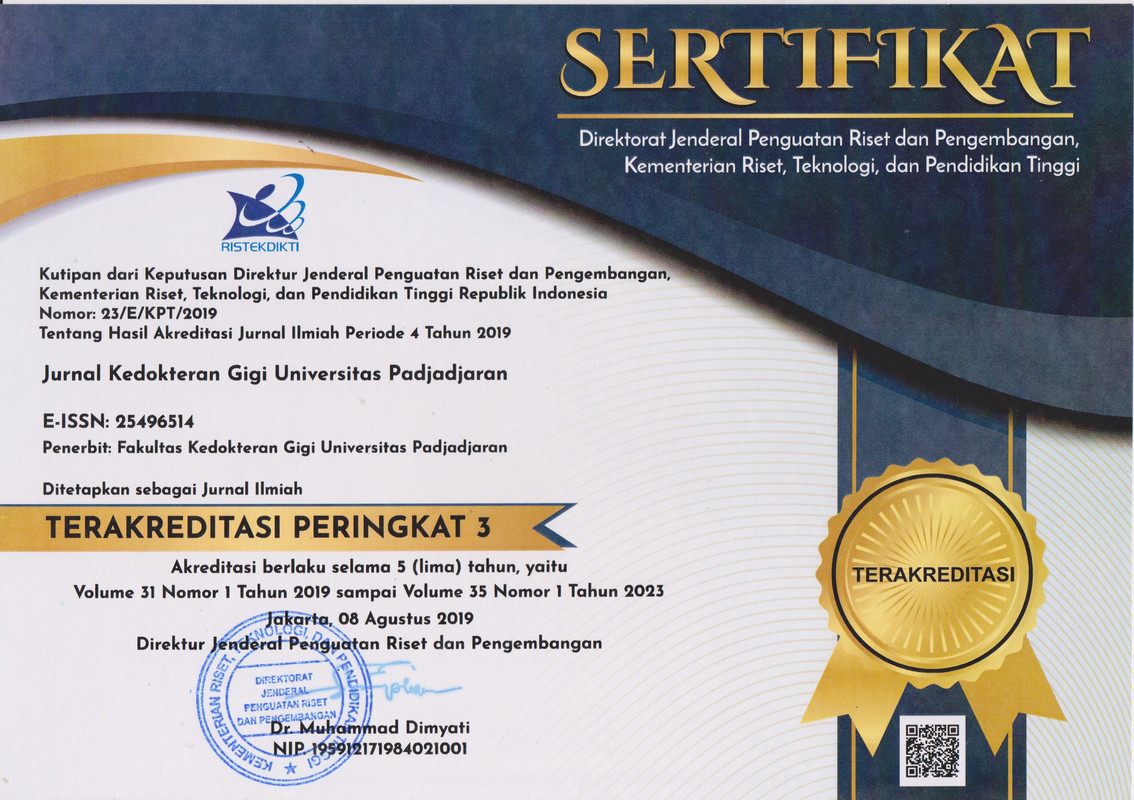Aktivitas antibakteri ekstrak kulit jeruk nipis (Citrus aurantifolia) terhadap bakteri Prevotella intermedia
Antibacterial activity of lime (Citrus aurantifolia) peel extract towards Prevotella intermedia
Abstract
Pendahuluan: Prevotella intermedia merupakan salah satu bakteri utama pada penyakit periimplantitis. Periimplantitis merupakan inflamasi jaringan lunak dan keras disekitar implan yang dapat dicegah menggunakan ekstrak tanaman antibakteri. Salah satunya yaitu kulit jeruk nipis, yang dapat menghambat proses inflamasi karena mengandung alkaloid, steroid, saponin, flavonoid, tanin sebagai senyawa antibakteri. Penelitian ini bertujuan untuk mengetahui peranan antibakteri kulit jeruk nipis dengan mengukur Konsentrasi Hambat Minimal (KHM) dan Konsentrasi Bunuh Minimal (KBM) ekstrak kulit jeruk nipis terhadap pertumbuhan bakteri Prevotella intermedia. Metode: Eksperimental laboratorium dengan rancangan penelitian post test only control group design. Pengujian KHM dan KBM dilakukan dengan metode dilusi, kulit jeruk nipis dimaserasi menggunakan pelarut etanol 70% sehingga didapatkan ekstrak kulit jeruk nipis dengan konsentrasi 0,78, 1,56, 3,125, 6,25, 12,5, 25, 50, dan 100% dengan chlorhexidine sebagai kontrol positif dan akuades sebagai kontrol negatif. Media kultur bakteri menggunakan Tripton Soya Agar. Hasil: Berdasarkan analisis statistik menggunakan Kruskal Wallis menunjukkan perbedaan penurunan jumlah koloni bakteri yang signifikan (p=0,0001) pada KBM dan KHM dari berbagai konsentrasi ekstrak kulit jeruk nipis terhadap pertumbuhan bakteri Prevotella intermedia, uji lanjutan Mann Whitney menunjukkan perbedaan penurunan jumlah koloni bakteri yang signifikan (p=0,021) antar masing-masing konsentrasi dan kelompok kontrol. Simpulan: Konsentrasi hambat minimal ekstrak kulit jeruk nipis terhadap bakteri Prevotella intermedia 12,5%, konsentrasi bunuh minimalnya 25%.
Kata kunci: agen antibakteri; ekstrak jeruk nipis; Prevotella intermedia
ABSTRACT
Introduction: Prevotella intermedia is one of the main bacteria in periimplantitis. Periimplantitis is inflammation of the soft and hard tissues around the implant that can be prevented using antibacterial plant extracts. One of them is lime peel, which can inhibit the inflammatory process due to its alkaloids, steroids, saponins, flavonoids, and tannins as antibacterial compounds. This study was aimed to determine the antibacterial activity of lime peel by measuring the Minimum Inhibitory Concentration (MIC) and Minimum Bactericidal Concentration (MBC) of lime peel extract on the growth of Prevotella intermedia. Methods: Experimental laboratory with post-test only control group design. The MIC and MBC tests were performed by the dilution method. The lime peel was macerated using 70% ethanol solvent to obtain lime peel extract with concentrations of 0.78, 1.56, 3.125, 6.25, 12.5, 25, 50, and 100% with chlorhexidine as a positive control and aquadest as a negative control. Bacterial culture media using Tripton Soy Agar. Results: Based on statistical analysis using Kruskal Wallis showed a significant difference in the decrease of the number of bacterial colonies (p=0.0001) in MBC and MIC from various concentrations of lime peel extract on the growth of Prevotella intermedia bacteria. Furthermore, the Mann Whitney follow-up test showed differences in the decrease of the number of bacterial colonies, which was significant (p=0.021) between each concentration and control group. Conclusions: The minimum inhibitory concentration of lime peel extract towards the growth of Prevotella intermedia was 12.5%, with the minimum bactericidal concentration of 25%.
Keywords: antibacterial agent; citrus extracts; Prevotella intermedia
Keywords
Full Text:
PDFReferences
Daftar Pustaka
Sheet P. Prevotella intermedia Live Culture. American Type Culture Collection. 2016:1(1):1–2.
Moon JH, Kim M, Lee JH. Genome sequence of Prevotella intermedia SUNY aB G8-9K-3, a biofilm forming strain with drug-resistance. Braz J Microbiol. 2017; 48(1): 5-6. DOI: 10.1016/j.bjm.2016.04.030.
Ishiguro K, Washio J, Sasaki K, Takahashi N. Real-time monitoring of the metabolic activity of periodontopathic bacteria. J Microbiol Methods. 2015; 115: 22-6. DOI: 10.1016/j.mimet.2015.05.015.
Wilson TG Jr, Valderrama P, Burbano M, Blansett J, Levine R, Kessler H, Rodrigues DC. Foreign bodies associated with peri-implantitis human biopsies. J Periodontol. 2015; 86(1): 9-15. DOI: 10.1902/jop.2014.140363.
Ruan Y, Shen L, Zou Y, Qi Z, Yin J, Jiang J, Guo L, He L, Chen Z, Tang Z, Qin S. Comparative genome analysis of Prevotella intermedia strain isolated from infected root canal reveals features related to pathogenicity and adaptation. BMC Genomics. 2015; 16(1): 122. DOI: 10.1186/s12864-015-1272-3.
Prahasanti C. Cosmetic and functional in modern periodontic. 1st ed. Surabaya: PPDGS Periodonsia Unair; 2017. h. 70-76.
Salvi GE, Cosgarea R, Sculean A. Prevalence and Mechanisms of Peri-implant Diseases. J Dent Res. 2017; 96(1): 31-7. DOI: 10.1177/0022034516667484.
Tungland B. Oral Dysbiosis and Periodontal Disease Effects on systemic physiology and in metabolic diseases, and effects of various therapeutic strategies. Human Microbiota in Health and Disease. 2018: 6(2): 421–461. DOI: 10.3390/dj6020010
Rhodes J, Feasby J, Goddard W, Beaney A, Baker M. The use of single growth medium for environmental monitoring of pharmacy aseptic units using tryptone soya agar with 1% glucose. Europ J Parenteral Pharm Sci. 2016: 21(2): 50-5.
How KY, Song KP, Chan KG. Porphyromonas gingivalis: An Overview of Periodontopathic Pathogen below the Gum Line. Front Microbiol. 2016; 7: 53. DOI: 10.3389/fmicb.2016.00053.
Zhang Y, Zhen M, Zhan Y, Song Y, Zhang Q, Wang J. Populationgenomic insights into variation in Prevotella intermedia and Prevotella nigrescens isolates and its association with periodontal disease. Front Cell Infect Microbiology. 2017: 7(1): 1–13. DOI: 10.3389/fcimb.2017.00409
Hakim RF, Editia A. Pengaruh air perasan jeruk nipis (Citrus aurantifolia) terhadap pertumbuhan bakteri lactobacillus acidophilus. Syiah Kuala Dent Soc. 2018: 1(3): 1–5.
Chismirina S, Rezeki S, Rusiawan. Konsentrasi hambat dan bunuh minimum ekstrak buah jamblang (Syzygium Cumini) terhadap pertumbuhan candida albicans. Cakradonya Dent Journal. 2014: 6(1): 619- 77.
Klinge B, Bertl K, Stavropoulos A. Periimplant diseases. Eur Oral Sci. 2018: 126(10): 88–94. DOI: 10.1111/eos.12529.
Lee A, Wang HL. Biofilm related to dental implants. J Indian Soc Periodontology 2013: 17(1): 5-11. DOI: 10.1097/ID.0b013e3181effa53.
Adi P, Sandi NF. Pengaruh ekstrak etanol kulit jeruk nipis (citrus aurantifolia) terhadap jumlah IL-6 pada gingiva tikus yang diinduksi actinobacillus actinomycetemcomitans. Jurnal Prodenta 2013: 1(1): 15– 23.
Purwanti N, Wahyudi. Pengaruh ekstrak kulit jeruk nipis (citrus aurantifolia swingle) konsentrasi 10% terhadap aktivitas enzim glukosiltransferase streptococcus mutans. Majalah Kedokteran Gigi Indonesia. 2013:20(2):126-131. DOI: 10.22146/majkedgiind.6803
Wardani R, Jekti DSD, Sedijani P. Uji aktivitas antibakteri ekstrak kulit buah jeruk nipis (citrus aurantifolia swingle) terhadap pertumbuhan bakteri isolat klinis. J Pen Pend IPA. 2018: 5(1): 10-7. DOI: 10.29303/jppipa.v5i1.101
DOI: https://doi.org/10.24198/jkg.v33i2.33226
Refbacks
- There are currently no refbacks.
Copyright (c) 2021 Jurnal Kedokteran Gigi Universitas Padjadjaran
INDEXING & PARTNERSHIP

Jurnal Kedokteran Gigi Universitas Padjadjaran dilisensikan di bawah Creative Commons Attribution 4.0 International License






.png)

















